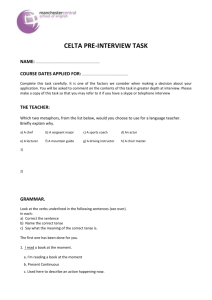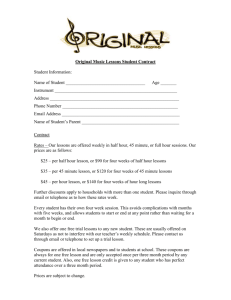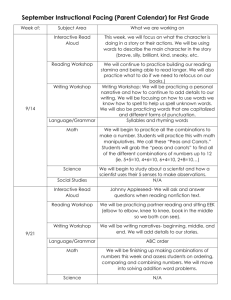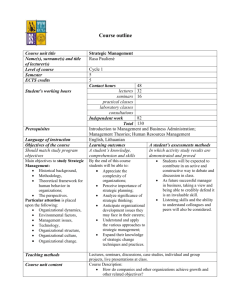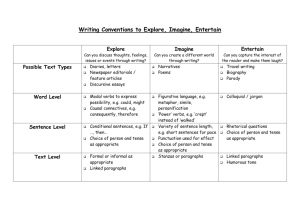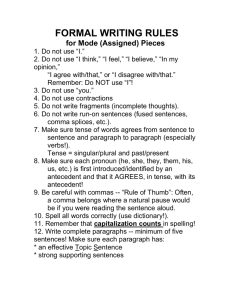Ideas for Vocabulary Review
advertisement
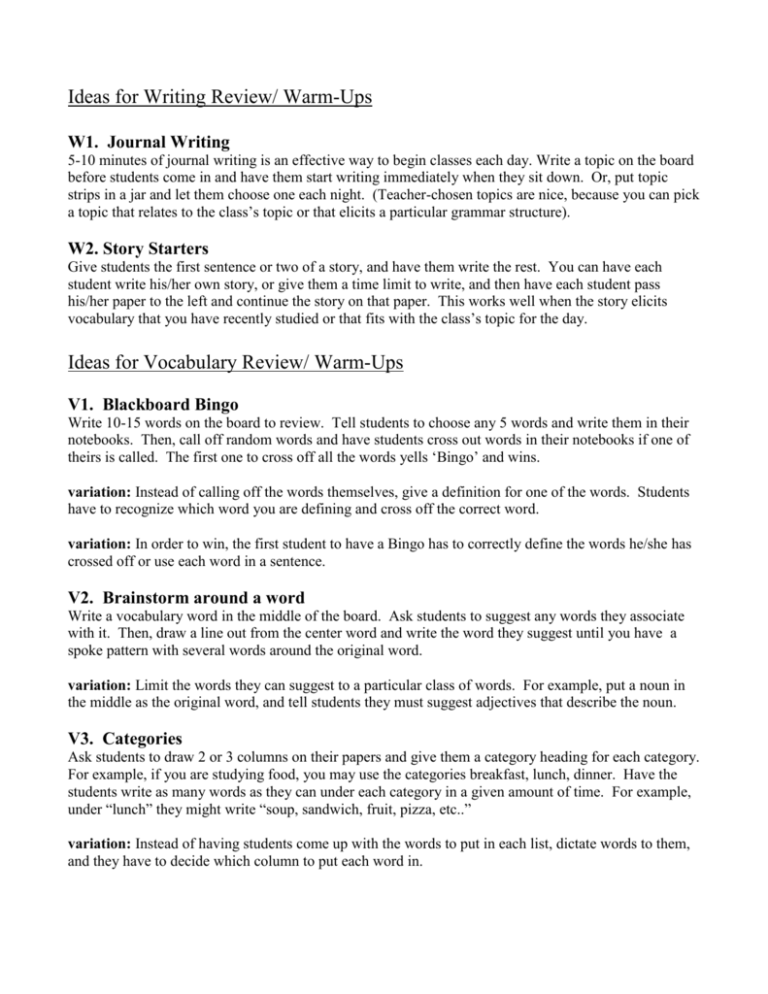
Ideas for Writing Review/ Warm-Ups W1. Journal Writing 5-10 minutes of journal writing is an effective way to begin classes each day. Write a topic on the board before students come in and have them start writing immediately when they sit down. Or, put topic strips in a jar and let them choose one each night. (Teacher-chosen topics are nice, because you can pick a topic that relates to the class’s topic or that elicits a particular grammar structure). W2. Story Starters Give students the first sentence or two of a story, and have them write the rest. You can have each student write his/her own story, or give them a time limit to write, and then have each student pass his/her paper to the left and continue the story on that paper. This works well when the story elicits vocabulary that you have recently studied or that fits with the class’s topic for the day. Ideas for Vocabulary Review/ Warm-Ups V1. Blackboard Bingo Write 10-15 words on the board to review. Tell students to choose any 5 words and write them in their notebooks. Then, call off random words and have students cross out words in their notebooks if one of theirs is called. The first one to cross off all the words yells ‘Bingo’ and wins. variation: Instead of calling off the words themselves, give a definition for one of the words. Students have to recognize which word you are defining and cross off the correct word. variation: In order to win, the first student to have a Bingo has to correctly define the words he/she has crossed off or use each word in a sentence. V2. Brainstorm around a word Write a vocabulary word in the middle of the board. Ask students to suggest any words they associate with it. Then, draw a line out from the center word and write the word they suggest until you have a spoke pattern with several words around the original word. variation: Limit the words they can suggest to a particular class of words. For example, put a noun in the middle as the original word, and tell students they must suggest adjectives that describe the noun. V3. Categories Ask students to draw 2 or 3 columns on their papers and give them a category heading for each category. For example, if you are studying food, you may use the categories breakfast, lunch, dinner. Have the students write as many words as they can under each category in a given amount of time. For example, under “lunch” they might write “soup, sandwich, fruit, pizza, etc..” variation: Instead of having students come up with the words to put in each list, dictate words to them, and they have to decide which column to put each word in. V4. Dictation Dictate sentences to students that use vocabulary from recent lessons. Or, dictate single vocabulary words for students to spell. variation: Have a dictation relay. Write several sentences or single words on a piece of paper and put it in the front of the room. Put students into pairs or groups. One student is the reader and another student is the writer. The reader must go up to the front of the room, read as much as he/she can, memorize it, and quickly go back and dictate it to the group while the writer writes it down. Then, the reader goes back to read the next part, memorizes it, and returns to the group to dictate it. Repeat the process until one group has finished. Check for accurate grammar and spelling (and accurate content!). V5. Erasing Words Write about 10 words on the board that the students are studying. Give the class time to look at them and remember how to spell them. Then, point to a word and erase it. Students must write the word with correct spelling in their notebooks. Do this until all the words are erased. V6. Favorites Write the names of about 5-6 related items on the board (different colors, different foods, different sports, etc.) Have students copy the words in their notebooks in the order of preference: their favorite should be 1. When they’ve finished, have them compare with others, or take a poll to see which choices are the most popular. V7. Feel the Object Bring in several items whose names have been recent vocabulary words. Put the items in a bag and have students feel the objects through the bag and try to identify them. (This would work well for classroom objects, possibly food, maybe some health terms, but would not work with more abstract words) V8. First, Second, Third Give students each a card with a vocabulary word on it. Have them line up according to alphabetical order of their words. You could leave one student without a card whose job it is to check the correctness of the order. variation: You could also do this with other concepts, such as how far they travel to school (for transportation/ length vocab.) or what time they wake up or go to bed (for time vocab.), etc. V9. Imaginary Classroom/ House To practice classroom words and/or prepositions, tell students to imagine that the classroom is empty— no furniture, no people, no objects. They have to create their idea classroom by describing what it could look like. (For example, there is a computer in the corner. There are six chairs around a table. There is a white board on that wall. There is a painting on the other wall. etc.) variation: Do the same activity using a room in a house instead of a classroom. V10. Miming Write a list of vocabulary on the board (this works best with verbs!). A student comes to the front of the class and mimes one of the words while the other students guess. When someone guesses it, erase that word and have another student come up to mime a new word. V11. Cloze Story Create a short story with some of the words missing (preferably vocab words that the students have recently studied). Students need to put the appropriate word in the space. variation: you can make this activity easier by providing a word bank with words to choose from. variation: you can make this a listening activity by reading the story aloud and students must listen for the missing words. V12. Recalling Words Write up to 15 words on the board that you want to review. Make sure they understand all of the words. Give students a couple minutes to look at the words and then erase or cover them. Individually or in pairs, have students try to remember as many words as they can and write them down. Whoever remembers the most wins. V13. Talking about a Picture Bring in a picture or draw one on the board (preferably one that relates to the topic you are studying). Students must look at the picture and make sentences about it (or just say words for lower level). See how many sentences the class can make in 3 minutes. Or, set a number of sentences they must get to. variation: Split the class into small groups. See which group can make the most grammatical sentences about the picture (or write the most words, for lower level). V14. Songs Choose a song that uses some of the vocabulary words you want to review. Prepare a cloze activity— write out the lyrics, but leave some words out. Students must fill in the missing words as they listen to the song. Students will remember the vocabulary best if the words you want to review are the words they must listen for. V15. Picture Stories Give students a set of pictures that tell a story related to your vocabulary words (like comic strip pictures). Have them use words you want to review to write dialogue or text to tell the story they see in the picture. Ideas for Pronunciation Review/ Warm-Ups P1. Jazz Chants Jazz chants are a great way to practice pronunciation features such as rhythm, intonation, consonant sounds, and vowel sounds. You can google jazz chants online, or use Carolyn Graham’s books of jazz chants. P2. The Way You Say It Write one word or short sentence on the board. Have students say it in different ways to convey different meanings. (For example, take the phrase “Good morning” Students can say it in a way to convey anger or sadness, they can say it with rising intonation to make it sound like a question, etc.) Talk about how different intonation will show different feelings or meanings. Ideas for Grammar Review/ Warm-Ups G1. Chain Story (practicing past tense) Tell the first sentence (or few sentences) of a story in the past tense. Then, go around the room and have each student tell the next part of the story. Have students pay attention to past tense verbs while they are listening. variation: Give each student a handout with the first sentence of a past-tense story. Give them 3minutes to add as much as they can to the story. Then, have them pass their paper to the left. Give them 3 more minutes to read and add to the story. (continue this for a few rounds). For the final interval, tell students that they need to write the ending for the story. At the end, have students underline/edit all the past tense verbs in the story that they have in front of them. Ask for a few volunteers to read particularly good stories. G2. Changing Sentences (practicing sentence structure) Write a sentence on the board with a pattern that you have been practicing. (For example, if you’ve been practicing simple present with adverbs of frequency, you could write, “She usually comes to class.”) Then have students one by one change one element of the sentence and write it on the board. It might go something like She usually comes to class. She never comes to class. She never goes to class. He never goes to class. He never goes to the bank. You never go to the bank. (etc…) G3. Compare Yourselves (practicing comparative adjectives) Put students in pairs and have them write or say sentences comparing themselves. (For example, “I am shorter than you are.”) To make it more difficult, tell them that they cannot use examples that they can see without talking—they have to have a conversation and ask questions to find the differences. G4. Correcting Mistakes (practicing any structure) Write several sentences on the board with deliberate mistakes in the grammar structure that you want to target. Have students work alone or in groups to correct the mistakes (you may want to tell them how many mistakes are in each sentence) G5. Expanding Headlines (practicing sentence structure) Pick out abbreviated headlines from news stories, like “U.S. Commander in Middle East to Retire Early” (or something simpler is ok too!). Have students use the information in the headline to create a complete sentence. G6. Find Someone Who… (practicing questions/ practicing verb tenses) Create a short list of statements using a verb tense that you have been practicing. Have students walk around and ask questions to find someone for whom the statement is true. (For example, to practice present perfect verbs: Find someone who… has traveled to Canada, has read a novel in English, has worked in a restaurant, has owned a pet fish, has driven a motorcycle, etc.) It’s good to focus on correct question formation or correct verb tense with this activity. G7. If I had a million dollars (practicing unreal conditionals) Ask students to generate ideas of what they would do if they won a million dollars. They need to use “would” conditionals in their answers. (For example, If I had a million dollars, I would travel to Antarctica.” It’s fun to use the song “If I Had a Million Dollars” by the bank Barenaked Ladies with this activity. G8. Jumbled Sentences (practicing sentence structure) Choose a sentence (or several sentences) that uses a grammar structure that you have been practicing. Write it on the board in a jumbled order or give students cards with one word on each card. Have them make correct sentences from the jumbled words. G9. What is he/she doing? (practicing present continuous) Ask for one volunteer student. Have the rest of the students close their eyes and listen. The volunteer should do something that makes a noise (like open the pages of a book, or dial a number on a cell phone). The students with their eyes closed need to guess what he/she is doing by calling out sentences using the present continuous (For example, “He is writing.” or “He is scratching the table.”). Choose another volunteer and do it again if you wish. G10. Simon Says (practicing commands) Play the traditional game Simon Says to practice new verbs using the command form. G11. Listen to a Song (practicing any grammar structure) Choose a song whose lyrics use a grammar structure that you are practicing. For example, “If I Had a Million Dollars” by the Barenaked Ladies shows a great use of conditionals. Many songs use the simple past, simple present, or continuous forms. Create a cloze worksheet in which students see most of the lyrics, but some of the words are missing (preferably, white out the words that use the target grammar structure). Students must listen carefully and fill in the words they hear. G12. Picture Stories (practicing past tense, past continuous) Give students a picture or a set of pictures that seems to tell a story (like a comic strip without any words). Have them create a text to go with the pictures, focusing on correct use of the past tense. G13. What could you do with it? (practicing modals could/might) Have two students stand up and face the class with their backs to the board. Write the name of a common object on the board (like a pencil, a telephone, a ball, etc.). Have students in the class suggest things that you could do (or might do) with the object. The two standing students have to guess what the object is. (For example, if the object a computer, students could say things like: “You could use it for homework.” “You might use it to surf the internet.” “You could use it to listen to music” etc…) Resources Penny Ur and Andrew Wright, Five-Minute Activities: A Resource Book of Short Activities. Cambridge University Press, 1992.
